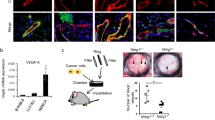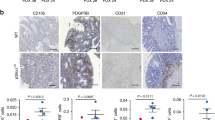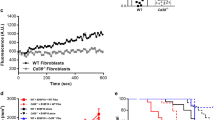Abstract
The importance of angiogenesis in malignant tumor growth has been interpreted mainly in terms of oxygen and nutrient supply. Here we demonstrate its fundamental role for tumor invasion of malignant human keratinocytes in surface transplants on nude mice. Distinct patterns of angiogenesis and vascular endothelial growth factor receptor-2 (VEGFR-2) expression allowed us to distinguish between benign and malignant cells. Functional inactivation of VEGF-R2 by a blocking antibody disrupted ongoing angiogenesis and prevented invasion of malignant cells, without reducing tumor cell proliferation. The reversion of a malignant into a benign phenotype by halting angiogenesis demonstrates a significant function of vascular endothelium for tumor invasion.
This is a preview of subscription content, access via your institution
Access options
Subscribe to this journal
Receive 12 print issues and online access
$209.00 per year
only $17.42 per issue
Buy this article
- Purchase on Springer Link
- Instant access to full article PDF
Prices may be subject to local taxes which are calculated during checkout
Similar content being viewed by others
References
Folkman J., Watson K., Ingber D. & Hanahan D. Induction of angiogenesis during the transition from hyperplasia to neoplasia. Nature 339, 58–61 (1989).
Gimbrone, M., Leapman, S., Cotran, R. & Folkman, J. Tumor dormancy in vivo by prevention of neovascularization. J. Exp. Med. 136, 261–276 (1972).
Nicosia R.F., Tchao R. & Leighton J. Interaction between newly formed endothelial channels and carcinoma cells in plasma clot culture. Clin. Exp. Metastasis 4, 91–104 (1986).
Hamada, J., Cavanaugh, P.G., Lotan, O. & Nicolson, G. Separable growth and migration factors for large-cell lymphoma cells secreted by microvascular endothelial Cells derived from target organs for metastasis. Br. J. Cancer 66, 349–354 (1992).
Rak, J.W., Filmus, J. & Kerbel, R.S. Reciprocal paracrine interactions between tumour cells and endothelial cells: The ‘angiogenesis progression’ hypothesis. Eur. J. Cancer 32A, 2438–2450 (1996).
Weidner, N. Intratumor microvessel density as a prognostic factor in cancer. Am. J. Pathol. 147, 9–15 (1995).
Liotta, L., Kleinerman, J. & Saidel F. Quantitative relationships of intravascular tumor cells, tumor vessels, and pulmonary metastases following tumor implantation. Cancer Res. 34, 997–1004 (1974).
Larcher, F. et al. Up-regulation of vascular endothelial growth factor/vascular permeability factor in mouse skin carcinogenesis correlates with malignant progression state and activated H-ras expression levels. Cancer Res. 56, 5391–5396 (1996).
Hanahan, D. & Folkman, J. Patterns and emerging mechanisms of the angiogenic switch during tumorigenesis. Cell 86, 353–364 (1996).
Christofori, G. & Hanahan, D. Molecular dissection of multistage tumorigenesis in transgenic mice. Semin. Cancer Biol. 5, 3–21 (1994).
Brooks, P.C. et al. Antiintegrin αvβ3 blocks human breast cancer growth and angiogenesis in human skin. J. Clin. Invest. 96, 1815–1822 (1995).
Ferrara, N. & Henzel, W.J. Pituitary follicular cells secrete a novel heparin-binding growth factor specific for vascular endothelial cells. Biochem. Biophys. Res. Commun. 161, 851–858 (1989).
Dvorak H.F., Brown L.F., Detmar, M. & Dvorak, A.M. Vascular permeability factor/vascular endothelial growth factor, microvascular hyperpermeability, and angiogenesis. Am. J. Pathol. 146, 1029–1039 (1995).
Alon T. et al. Vascular endothelial growth factor acts as a survival factor for newly formed retinal vessels and has implications for retinopathy of prematurity. Nature Med. 1, 1024–1028 (1995).
Terman B.I. & Dougher-Vermazen M. Biological properties of VEGF/VPF receptors. Cancer Metastasis Rev. 15 159–163 (1996).
Kim K.J. et al. Inhibition of vascular endothelial growth factor induced angiogenesis suppresses tumour growth in vivo. Nature 362, 841–844 (1993).
Cheng, S.-Y. et al. Suppression of glioblastoma angiogenicity and tumoriogenicity by inhibition of endogenous expression of vascular endothelial growth factor. Proc. Natl. Acad. Sci. USA 93, 8502–8507 (1996).
Millauer, B., Shawver, L.K., Plate, K.H., Risau, W. & Ullrich, A. Glioblastoma growth inhibited in vivo by a dominant-negative flk-1 mutant. Nature 367, 576–579 (1994).
Millauer, B. et al. Dominant-negative inhibition of flk-1 suppresses the growth of many tumor types in vivo. Cancer Res. 56, 1615–1620 (1996).
Warren, R.S., Yuan, H., Matli, M.R., Gillett, N.A. & Ferrara, N. Regulation by vascular endothelial growth factor of human colon cancer tumorigenesis in a mouse model of experimental liver metastasis. J. Clin. Invest. 95, 1789–1797 (1995).
Ferrara, N. et al. Expression of vascular endothelial growth factor does not promote transformation but confers a growth advantage in vivo to Chinese hamster ovary cells. J. Clin. Invest. 91, 160–170 (1993).
Zhang, H.-T. et al. Enhancement of tumor growth and vascular density by transfection of vascular endothelial cell growth factor into MCF-7 human breast carcinoma cells. J. Natl. Cancer Inst. 87, 213–219 (1995).
Claffey, K.P. et al. Expression of vascular permeability factor/vascular endothelial growth factor by melanoma cells increases tumor growth, angiogenesis and experimental metastasis. Cancer Res. 56, 172–181 (1996).
Detmar, M. Molecular regulation of angiogenesis in the skin. J. Invest. Dermatol. 106, 207–208 (1996).
Boukamp, P. et al. Normal keratinization in a spontaneously immortalized aneuploid human keratinocyte cell line. J. Cell Biol. 106, 761–771 (1988).
Boukamp, P., Stanbridge, E.J., Foo, D.Y., Cerutti, P.A. & Fusenig, N.E. c-Ha-ras oncogene expression in immortalized human keratinocytes (HaCaT) alters growth potential in vivo but lacks correlation with malignancy. Cancer Res. 50, 2840–2847 (1990).
Boukamp, P. et al. Step-wise progression in human skin carcinogenesis in vitro involves mutational inactivation of p53, rasH oncogene activation and additional chromosome loss. Oncogene 11, 961–969 (1995).
Fusenig, N.E., Breitkreutz, D., Bohnert, A. & Mackenzie, I.C. Epithelial-mesenchymal interactions in tissue homeostasis and malignant transformation. in: Oral Cancer (ed. Johnson, N. W.) 218–248 (Cambridge Univ. Press, Cambridge, 1991).
Breitkreutz, D. et al. Epidermal morphogenesis and keratin expression in c-Ha-ras-transfected tumorigenic clones of the human HaCaT cell line. Cancer Res. 51, 4402–4409 (1991).
Rockwell, P., Neufeld, G., Classman, A., Caron, D. & Goldstein, N. In vitro neutralization of vascular endothelial growth factor activation of flk-1 by a monoclonal antibody. Mol. Cell Differ. 3(1) 91–109 (1995).
Saez, E. et al. C-fos is required for malignant progression of skin tumors. Cell 82, 721–732 (1995).
Parangi, S. et al. Antiangiogenic therapy of transgenic mice impairs de novo tumor growth. Proc. Natl. Acad. Sci. USA 93, 2002–2007 (1996).
Relf M. et al. Expression of the angiogenic factors vascular endothelial cell growth factor, acidic and basic fibroblast growth factor, tumor growth factor β-1, platelet-derived endothelial cell growth factor, placenta growth factor, and pleiotrophin in human primary breast cancer and its relation to angiogenesis. Cancer Res. 57, 963–969 (1997).
Mandriota, S.J., Menoud, A.-P. & Pepper, M.S. Transforming growth factor β1 downregulates vascular endothelial growth factor receptor 2/flk-1 in vascular endothelial cells. J. Biol. Chem. 271, 11500–11505 (1996).
Patterson, C. et al. Downregulation of vascular endothelial growth factor receptors by tumor necrosis factor a in cultured human vascular endothelial cells. J. Clin. Invest. 98, 490–496 (1996).
Yoshida, A., Anandapte, B. & Zetter, B.R. Differential endothelial migration and proliferation to basic fibroblast growth factor and vascular endothelial growth factor. Growth Factors 13, 57–64 (1996).
Holmgren, L., O'Reilly, M.S. & Folkman, J. Dormancy of micrometastases: Balanced proliferation and apoptosis in the presence of angiogenesis suppression. Nature Med 1, 149–153 (1995).
Tischer, E. et al. The human gene for vascular endothelial growth factor: Multiple protein forms are encoded through alternative exon splicing. J. Biol. Chem. 266, 11947–11954 (1991).
Millauer, B. et al. High affinity VEGF binding and developmental expression suggest flk-1 as a major regulator of vasculogenesis and angiogenesis. Cell 72, 835–846 (1993).
Moorman, A.F.M., De-Boer, P.A.J., Vermeulen, J. Vermeulen, J.L.M. Lamers W.H. Practical aspects of radio-isotopic in situ hybridization on RNA. Histochem. J. 25, 251–266 (1992).
Author information
Authors and Affiliations
Rights and permissions
About this article
Cite this article
Skobe, M., Rockwell, P., Goldstein, N. et al. Halting angiogenesis suppresses carcinoma cell invasion. Nat Med 3, 1222–1227 (1997). https://doi.org/10.1038/nm1197-1222
Received:
Accepted:
Issue Date:
DOI: https://doi.org/10.1038/nm1197-1222
This article is cited by
-
Modern therapies of nonsmall cell lung cancer
Journal of Applied Genetics (2023)
-
AXL is required for hypoxia-mediated hypoxia-inducible factor-1 alpha function in glioblastoma
Toxicological Research (2023)
-
Consensus guidelines for the use and interpretation of angiogenesis assays
Angiogenesis (2018)
-
Evaluation of Magnetonanoparticles Conjugated with New Angiogenesis Peptides in Intracranial Glioma Tumors by MRI
Applied Biochemistry and Biotechnology (2017)
-
Evaluation of GX1 and RGD-GX1 peptides as new radiotracers for angiogenesis evaluation in experimental glioma models
Amino Acids (2016)



